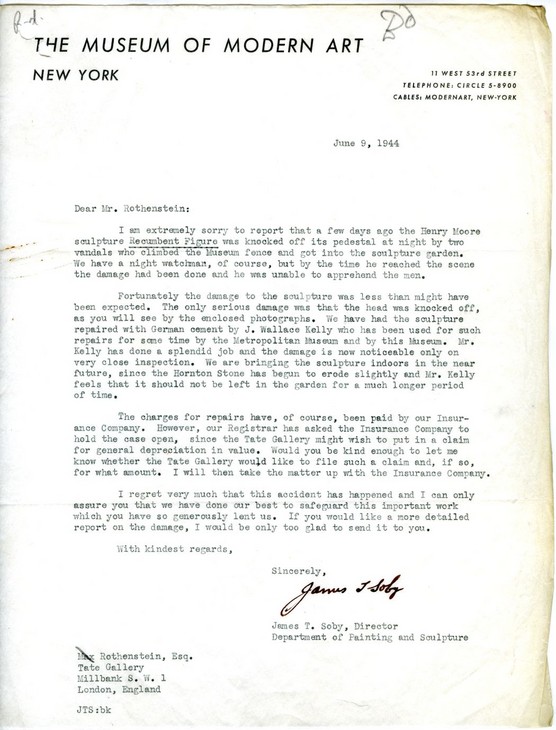James Thrall Soby Letter to John Rothenstein 9 June 1944
In 1939 Henry Moore’s sculpture Recumbent Figure 1938 (Tate N05387) had been sent to New York for inclusion in the British Pavilion at the World’s Fair. When the Second World War broke out in Europe, it was impossible for the sculpture to return to the Tate Gallery, and the sculpture was eventually placed in the care of the Museum of Modern Art, New York (MoMA), for the duration of the war.
Here James Soby, Director of the Department of Painting and Sculpture at MoMA, writes to John Rothenstein, Director of the Tate Gallery, to inform him of damage done to the sculpture in June 1944. Two vandals had broken into MoMA’s sculpture garden in the middle of the night and knocked Recumbent Figure off its plinth. The figure’s head was knocked off but the museum had quickly cemented it back on (‘the damage is now noticeable only on very close inspection’).
Transcript
[Letterhead:]
THE MUSEUM OF MODERN ART
NEW YORK
NEW YORK
11 WEST 53rd STREET
TELEPHONE: CIRCLE 5-8900
CABLES: MODERNART, NEW-YORK
TELEPHONE: CIRCLE 5-8900
CABLES: MODERNART, NEW-YORK
[Typescript with handwritten signature:]
June 9, 1944
Dear Mr. Rothenstein:
I am extremely sorry to report that a few days ago the Henry Moore sculpture Recumbent Figure was knocked off its pedestal at night by two vandals who climbed the Museum fence and got into the sculpture garden. We have a night watchman, of course, but by the time he reached the scene the damage had been done and he was unable to apprehend the men.
Fortunately the damage to the sculpture was less than might have been expected. The only serious damage was that the head was knocked off, as you will see by the enclosed photographs. We have had the sculpture repaired with German cement by J. Wallace Kelly who has been used for such repairs for some time by the Metropolitan Museum and by this Museum. Mr. Kelly has done a splendid job and the damage is now noticeable only on very close inspection. We are bringing the sculpture indoors in the near future, since the Horton Stone has begun to erode slightly and Mr. Kelly feels that it should not be left in the garden for a much longer period of time.
The charges for repairs have, of course, been paid by our Insurance Company. However, our Registrar has asked the Insurance Company to hold the case open, since the Tate Gallery might wish to put in a claim for general depreciation in value. Would you be kind enough to let me know whether the Tate Gallery would like to file such a claim and, if so, for what amount. I will then take the matter up with the Insurance Company.
I regret very much that this accident has happened and I can only assure you that we have done our best to safeguard this important work which you have so generously lent us. If you would like a more detailed report on the damage, I would be only too glad to send it to you.
With kindest regards,
Sincerely,
James T Soby
James T. Soby, Director
Department of Painting and Sculpture
James T. Soby, Director
Department of Painting and Sculpture
Max [crossed through] Rothenstein, Esq.
Tate Gallery
Millbank SW1
London, England.
Tate Gallery
Millbank SW1
London, England.
JTS:bk.
How to cite
James Thrall Soby, Letter to John Rothenstein, 9 June 1944, in Henry Moore: Sculptural Process and Public Identity, Tate Research Publication, 2015, https://www

